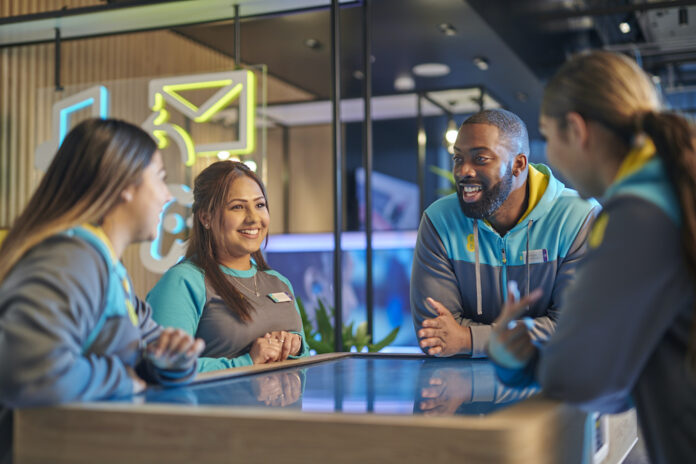Customers interact with technology and experience human empathy
In December EE unveiled the Shop of the Future, its protype for better mobile retail experiences.
The new futuristic concept store is in Aldgate, in BT’s new HQ. The new shop will be a testing ground for new retail ideas and has experiential zones where customers can see what their handsets and gaming systems could do if they had superfast broadband.
Among the futuristic concepts unveiled at the press event were: bookable event space for the local community, repair and recycling facilities and executive interactive technology. The main asset though could be its people, since human empathy is rare in digital society.
Store of the future
The Aldgate store is on the intersection of one of Europe’s richest communities, the city of London, and one of its poorest, Whitechapel. Both are invited to use the community space, which could be a useful social experiment if the communities interact and create mutual benefits.
The EE shop aims to address one of the unreported, possibly worst, mobile telephony customer experiences, environment guilt. Rising awareness of the carbon footprint of everything can leave a nasty aftertaste for the phone purchasing public. As a side effect of this, equipment hoarding is on the rise in the UK, according to research. Hoarding is a behaviour linked to stress.
Donating kit can spark joy
The EE shop of the future aims to tackle this ‘consumption guilt’ by accepting old equipment and giving the customer another pleasant experience, in the form of credits or a charity donation. The third sustainability dividend for the consumer is the chance to prolong the life of their Android handsets through a new in-store repair scheme.
The British mobile shop was so notoriously bad it was the basis of a TV comedy series but EE has improved the sense of empowerment in customers. The EE shop has worked on the knowledge transfer to customers with creative uses of interactive technology. Touchscreens and QR codes give the customer more data. Demo areas give them the hands on feel of games consoles, streaming platforms and fitness gear.
Experiential space for customers
“We’ve created an experiential space where customers can get expert advice, or just have some fun with the very latest technology,” said Bridget Lea, MD of Commercial in BT’s Consumer Division, “we know there’s no substitute for getting help from an expert in person.”
The biggest improvement is that staff seem much more helpful. Data is one thing but only well trained, empathetic staff can give customers the context they need. These are the works in progress for EE’s prototype shop, before it rolls them out across the country.
Mobile operators are testing new ways of communicating with their customers. Some are investigating whether human interaction is more effective than network latency in improving the customer experience. In November a Mobileum survey said better customer experience is the top goal for mobile operators in 2022.
In response many operators are throwing technology such as artificial intelligence, at the problem. In July Virgin Media claimed that broadband speeds are a customer experience that adds £10,000 to house values.
It’s not just about the network
However in October a Global State of Mobile Experience study seemed to indicate that network coverage and speed is not everything. The results showed that mobile operators in some of the most developed economies gave their customers the worst perceptions of good service. The study concluded that British mobile subscribers had the 37th lowest perception of customer experience out of all the G8 countries in the test. Germany and France came 25th and 26th in the ranking.
Some operators have recognised that customer experience is not purely guaranteed by network speeds. Recent reports on Deutsche Telekom (DT), Three (Eire & UK) and BT EE have all alluded to the need to improve human interaction, either online or in person.
Blind test
Mobile Europe returned to the shop a week after the official press event to conduct a blind test. The staff seem much more intelligent and read to engage than in the average UK outlet. Yasmine, who talked through my upgrade options, works part time and is training to be a dentist. Her patient extraction of information and advice raised the bar substantially on all my previous phone shop experiences.
The biggest difference, in the EE flagship store, is that the staff to talk with you, rather than at you. This might sound a small step in other parts of Europe but it’s a giant leap in the British mobile phone shop experience. You get the impression the EE staff actually like sharing their knowledge, whereas the body language in most phone shops says ‘read the manual’.
Keen attention is crucial
“I love trying out all the different systems and learning about them,” said another staff member Khadija Hakhtar who juggles work with being a third-year law student. It might have been EE’s customer experiene training or her legal ambitions but she did seem a good advocate for each system, and made each case with clarity and enthusiasm, without being pushy. “I can’t believe how lucky I am working here,” said Hakhtar.
EE says these new customer experience concepts will be tested and then potentially rolled out across all its stores.



